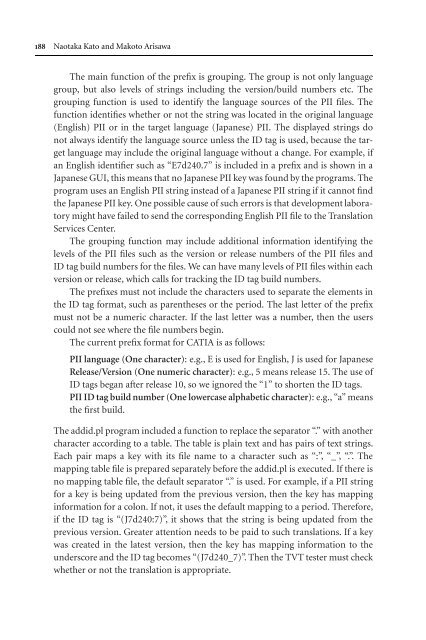Topics in Language Resources for Translation ... - ymerleksi - home
Topics in Language Resources for Translation ... - ymerleksi - home
Topics in Language Resources for Translation ... - ymerleksi - home
- No tags were found...
You also want an ePaper? Increase the reach of your titles
YUMPU automatically turns print PDFs into web optimized ePapers that Google loves.
188 Naotaka Kato and Makoto ArisawaThe ma<strong>in</strong> function of the prefix is group<strong>in</strong>g. The group is not only languagegroup, but also levels of str<strong>in</strong>gs <strong>in</strong>clud<strong>in</strong>g the version/build numbers etc. Thegroup<strong>in</strong>g function is used to identify the language sources of the PII files. Thefunction identifies whether or not the str<strong>in</strong>g was located <strong>in</strong> the orig<strong>in</strong>al language(English) PII or <strong>in</strong> the target language (Japanese) PII. The displayed str<strong>in</strong>gs donot always identify the language source unless the ID tag is used, because the targetlanguage may <strong>in</strong>clude the orig<strong>in</strong>al language without a change. For example, ifan English identifier such as “E7d240.7” is <strong>in</strong>cluded <strong>in</strong> a prefix and is shown <strong>in</strong> aJapanese GUI, this means that no JapanesePIIkeywasfoundbytheprograms.Theprogram uses an English PII str<strong>in</strong>g <strong>in</strong>stead of a Japanese PII str<strong>in</strong>g if it cannot f<strong>in</strong>dthe Japanese PII key. One possible cause of such errors is that development laboratorymight have failed to send the correspond<strong>in</strong>g English PII file to the <strong>Translation</strong>Services Center.The group<strong>in</strong>g function may <strong>in</strong>clude additional <strong>in</strong><strong>for</strong>mation identify<strong>in</strong>g thelevels of the PII files such as the version or release numbers of the PII files andID tag build numbers <strong>for</strong> the files. We can have many levels of PII files with<strong>in</strong> eachversion or release, which calls <strong>for</strong> track<strong>in</strong>g the ID tag build numbers.The prefixes must not <strong>in</strong>clude the characters used to separate the elements <strong>in</strong>the ID tag <strong>for</strong>mat, such as parentheses or the period. The last letter of the prefixmust not be a numeric character. If the last letter was a number, then the userscould not see where the file numbers beg<strong>in</strong>.The current prefix <strong>for</strong>mat <strong>for</strong> CATIA is as follows:PII language (One character): e.g., E is used <strong>for</strong> English, J is used <strong>for</strong> JapaneseRelease/Version (One numeric character): e.g., 5 means release 15. The use ofID tags began after release 10, so we ignored the “1” to shorten the ID tags.PII ID tag build number (One lowercase alphabetic character): e.g., “a” meansthe first build.The addid.pl program <strong>in</strong>cluded a function to replace the separator “.” with anothercharacter accord<strong>in</strong>g to a table. The table is pla<strong>in</strong> text and has pairs of text str<strong>in</strong>gs.Each pair maps a key with its file name to a character such as “:”, “_”, “.”. Themapp<strong>in</strong>g table file is prepared separately be<strong>for</strong>e the addid.pl is executed. If there isno mapp<strong>in</strong>g table file, the default separator “.” is used. For example, if a PII str<strong>in</strong>g<strong>for</strong> a key is be<strong>in</strong>g updated from the previous version, then the key has mapp<strong>in</strong>g<strong>in</strong><strong>for</strong>mation <strong>for</strong> a colon. If not, it uses the default mapp<strong>in</strong>g to a period. There<strong>for</strong>e,if the ID tag is “(J7d240:7)”, it shows that the str<strong>in</strong>g is be<strong>in</strong>g updated from theprevious version. Greater attention needs to be paid to such translations. If a keywas created <strong>in</strong> the latest version, then the key has mapp<strong>in</strong>g <strong>in</strong><strong>for</strong>mation to theunderscore and the ID tag becomes “(J7d240_7)”. Then the TVT tester must checkwhetherornotthetranslationisappropriate.
















